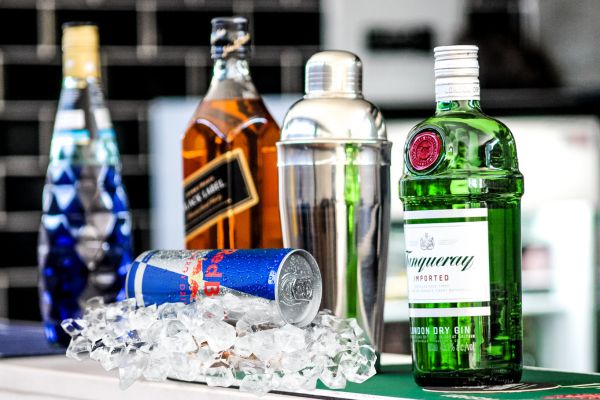The non-alcoholic beverage industry has exploded in recent years, offering more than enough options for those looking to skip the alcohol but not the flavor. What’s more, this trend is clear to stay.
As more people embrace sobriety or simply cut back on alcohol consumption, beverage companies have stepped up to the plate, delivering innovative and delicious alternatives.
From herbal teas to zero-proof spirits, there’s never been a better time to explore the world of non-alcoholic drinks. Let’s dive into the top 10 companies leading this refreshing trend.
1. Spindrift
Spindrift is a sparkling water brand that infuses squeezed fruit into its products. Actually, Spindrift uses only real squeezed fruit instead of relying on artificial flavors, and this commitment to authenticity has resonated with consumers, allowing Spindrift to enjoy rapid growth in the competitive sparkling water category.
Fan favorites like Raspberry Lime, Pineapple, and Grapefruit showcase the brand’s dedication to natural flavors without artificial sweeteners. Spindrift’s success proves that sometimes, less really is more when it comes to ingredients.
2. Waterloo
Waterloo has become a darling of the health-conscious crowd by offering bold flavors without any sweeteners. As one of the fastest-growing sparkling water brands in the US, Waterloo has carved out a niche with its zero–calorie, non-GMO Project-verified products.
Their Black Cherry, Watermelon, and Grape flavors have quickly gained a following, showing consumers are eager for options that deliver taste without compromise.
3. Seedlip
Seedlip is the world’s first distilled non-alcoholic spirit brand. Launched in 2015, it has grown quickly and pioneered the “what to drink when you’re not drinking” movement.
Their adult-oriented alternatives to alcohol, such as Seedlip Garden 108 and Seedlip Spice 94, have found a home in high-end bars and restaurants worldwide, showing a growing demand for nuanced non-alcoholic options that can stand in for traditional spirits.
4. Fever-Tree
Known for its premium mixers, Fever-Tree has become the go-to brand for crafting non-alcoholic cocktails. As the leader in the premium mixer category, Fever-Tree’s Indian Tonic Water and Ginger Beer have become staples at cocktail bars and in-home cocktail kits alike.
The brand’s focus on high-quality ingredients has made it a favorite among mixologists and consumers looking to elevate their mocktail game.
5. GT’s Living Foods
GT’s has established itself as a powerhouse in the kombucha market, offering a range of probiotic-rich fermented beverages. As the largest kombucha brand in the US, GT has helped bring this once-niche drink into the mainstream.
Popular flavors like Gingerade, Trilogy, and Synergy have won over consumers with their tangy profiles. GT’s commitment to raw, organic ingredients and probiotic benefits has positioned the brand as a leader in the functional beverage space.
6. Zevia
Zevia plays a vital role in the stevia-sweetened soda market, offering a healthier alternative to traditional soft drinks. As a leader in the natural zero-calorie soda category, Zevia has shown that it’s possible to enjoy familiar soda flavors without the sugar crash.
Their Cola and Ginger Root Beer have won over consumers seeking guilt-free alternatives to conventional sodas.
7. Remedy Kombucha
Remedy has ridden the fermented tea wave to become one of the fastest-growing kombucha brands globally. By making kombucha accessible and delicious, Remedy expanded the market for this probiotic-rich beverage.
Flavors like Raspberry Lemonade and Ginger Lemon are very popular.
8. Ghia
A relative newcomer in the non-alcoholic drink space, Ghia has quickly made a name for itself with its sophisticated alternative to evening cocktails. Rapidly growing in the premium non-alcoholic category, Ghia’s Non-Alcoholic Apéritif offers a complex, bitter flavor profile reminiscent of traditional aperitifs.
This unique offering caters to those seeking a more adult, refined, non-alcoholic option, proving that abstaining from alcohol doesn’t mean sacrificing the sophistication many associated with cocktails.
9. Athletic Brewing Company
Leading the charge in non-alcoholic craft beer, Athletic Brewing has won over even the most discerning beer enthusiasts. As the largest non-alcoholic craft brewery in the US, Athletic Brewing offers full-flavored craft beers without the alcohol.
Their Run Wild IPA and Upside Dawn Golden Ale have shown that it’s possible to create compelling non-alcoholic versions of beloved beer styles. Athletic Brewing’s success indicates a growing market for craft non-alcoholic options that don’t compromise on taste or complexity.
10. Curious Elixirs
Curious Elixirs is making waves by crafting booze-free cocktails in a bottle, bringing bar-quality drinks to your home. With a growing presence in the ready-to-drink non-alcoholic cocktail market, Curious Elixirs offers complex, layered flavors mimicking classic cocktails.
Their Curious No. 1 (inspired by a Pomegranate Negroni) and Curious No. 2 (a take on a Spicy Margarita) showcase the potential for non-alcoholic beverages to capture the essence of traditional cocktails. Curious Elixirs’ innovation speaks to a desire for convenient, sophisticated, non-alcoholic options.
The Importance of Non-Alcoholic Beverages
The rise of non-alcoholic beverages isn’t just a boon for those looking for alternatives to alcoholic drinks. It’s also a win for everyone’s health. These drinks often boast lower calories, no hangovers, little to no sugar, and, in many cases, added health benefits like probiotics or vitamins.
As consumers become more health-conscious, the shift towards non-alcoholic options has accelerated, with many people embracing “sober curious” lifestyles.
This trend has had a significant impact on the beverage industry. While alcoholic beverage sales have remained relatively flat in recent years, the non-alcoholic sector has seen impressive growth, showing that there is a large market for non-alcoholic beverages that remains largely untapped.
Enjoy the Best Non-Alcoholic Beverages
The non-alcoholic beverage landscape has never been more exciting or diverse. From kombucha pioneers like GT’s Living Foods to innovative startups like Seedlip and Ghia, companies are pushing the boundaries of what’s possible in a glass – no alcohol required.
Non-alcoholic beverages are more than just a fad. They represent a shift in how we think about drinking and socializing. Whether you’re in recovery, cutting back on alcohol, or simply looking for new flavors to explore, there’s a whole world of delicious, sophisticated, non-alcoholic options waiting for you.
So next time you’re out with friends or relaxing at home, why not raise a glass of something new? Your taste buds – and your health – will thank you. Cheers to good times and great drinks; no hangover is required!









